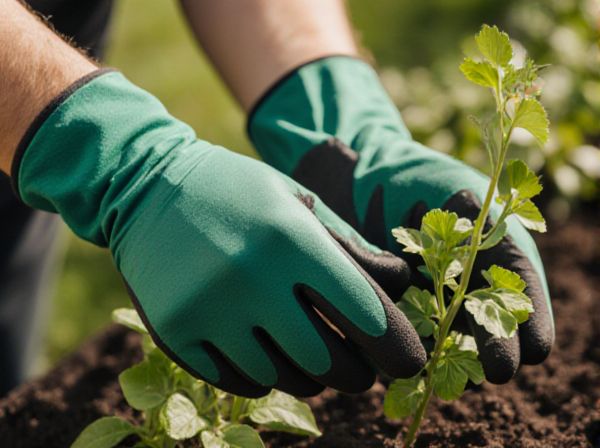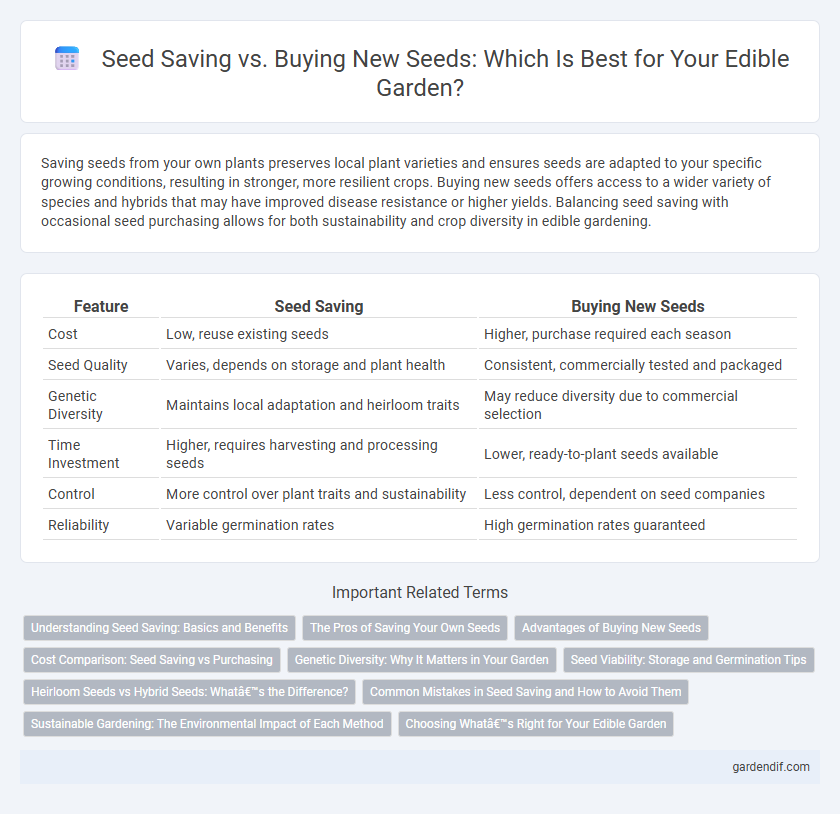
Seed saving vs buying new seeds Illustration
Saving seeds from your own plants preserves local plant varieties and ensures seeds are adapted to your specific growing conditions, resulting in stronger, more resilient crops. Buying new seeds offers access to a wider variety of species and hybrids that may have improved disease resistance or higher yields. Balancing seed saving with occasional seed purchasing allows for both sustainability and crop diversity in edible gardening.
Table of Comparison
| Feature | Seed Saving | Buying New Seeds |
|---|---|---|
| Cost | Low, reuse existing seeds | Higher, purchase required each season |
| Seed Quality | Varies, depends on storage and plant health | Consistent, commercially tested and packaged |
| Genetic Diversity | Maintains local adaptation and heirloom traits | May reduce diversity due to commercial selection |
| Time Investment | Higher, requires harvesting and processing seeds | Lower, ready-to-plant seeds available |
| Control | More control over plant traits and sustainability | Less control, dependent on seed companies |
| Reliability | Variable germination rates | High germination rates guaranteed |
Understanding Seed Saving: Basics and Benefits
Understanding seed saving involves preserving seeds from mature plants to cultivate future crops, ensuring genetic diversity and adaptability. This practice reduces reliance on commercial seed companies, lowers costs, and promotes sustainability by maintaining heirloom varieties unique to local environments. Seed saving enhances food security by enabling gardeners to select seeds best suited to their climate and soil conditions.
The Pros of Saving Your Own Seeds
Saving your own seeds preserves plant varieties that thrive in your specific climate, ensuring stronger, more resilient crops over time. It reduces costs by eliminating the need to purchase new seeds annually, promoting sustainable gardening practices. Seed saving also supports biodiversity by maintaining heirloom and rare plant genetics that might be lost when relying solely on commercial seed sources.
Advantages of Buying New Seeds
Buying new seeds ensures access to the latest, genetically improved varieties that offer higher yields, disease resistance, and climate adaptability. Fresh seeds often have higher germination rates compared to stored seeds, resulting in better crop establishment and productivity. Purchasing seeds from reputable suppliers also reduces the risk of introducing pests or diseases into your garden.
Cost Comparison: Seed Saving vs Purchasing
Saving seeds significantly reduces expenses over time by eliminating the need to buy new seeds each planting season, making it a cost-effective approach for gardeners. Initial investments in quality seed-saving tools and storage are offset by the continual reuse of seeds, resulting in long-term savings. Conversely, purchasing new seeds annually can become costly, especially for heirloom or rare varieties, increasing overall gardening expenses.
Genetic Diversity: Why It Matters in Your Garden
Saving seeds preserves the genetic diversity essential for resilient gardens, enabling plants to adapt to local conditions and resist pests naturally. Buying new seeds often leads to uniform crops, reducing biodiversity and increasing vulnerability to diseases and climate changes. Maintaining a diverse gene pool through seed saving supports sustainable agriculture and enhances long-term food security.
Seed Viability: Storage and Germination Tips
Seed viability strongly influences successful crop production, with saved seeds requiring careful storage conditions to maintain germination rates. Optimal storage involves cool, dry, and dark environments, ideally below 50degF and 50% humidity, to prolong seed life and preserve genetic traits. Regular germination testing ensures seed viability before planting, helping gardeners decide between using saved seeds or purchasing fresh seeds for consistent crop yields.
Heirloom Seeds vs Hybrid Seeds: What’s the Difference?
Heirloom seeds are open-pollinated varieties preserved for generations, allowing gardeners to save seeds that breed true to type, maintaining consistent plant traits and flavors. Hybrid seeds result from cross-pollinating two distinct parent plants to enhance specific qualities like disease resistance or yield, but seeds saved from hybrids often produce unpredictable offspring. Choosing heirloom seeds supports biodiversity and seed sovereignty, while hybrid seeds offer uniformity and performance advantages for commercial growers.
Common Mistakes in Seed Saving and How to Avoid Them
Common mistakes in seed saving include harvesting seeds from hybrid plants, which often produce unpredictable offspring, and failing to dry seeds thoroughly, leading to mold and poor germination. Contamination from cross-pollination can compromise seed purity, so isolating plant varieties or using physical barriers is essential. Proper labeling, storing seeds in cool, dry conditions, and regular viability testing help preserve seed quality for future planting cycles.
Sustainable Gardening: The Environmental Impact of Each Method
Seed saving reduces the demand for commercially produced seeds, minimizing carbon emissions associated with industrial agriculture and transportation. It promotes genetic diversity and resilience by preserving heirloom and native plant varieties adapted to local ecosystems. Buying new seeds often supports large-scale monoculture farming, which can deplete soil health and increase reliance on chemical inputs, negatively impacting long-term sustainability.
Choosing What’s Right for Your Edible Garden
Saving seeds from heirloom tomatoes and open-pollinated vegetables preserves genetic diversity and adapts plants to local growing conditions, ensuring stronger yields over time. Buying new seeds offers access to hybrid varieties with improved disease resistance, faster growth, and unique flavors essential for diverse edible gardens. Balancing saved seeds with selective new purchases empowers gardeners to customize their crops for sustainability, productivity, and taste.
Seed saving vs buying new seeds Infographic

 gardendif.com
gardendif.com